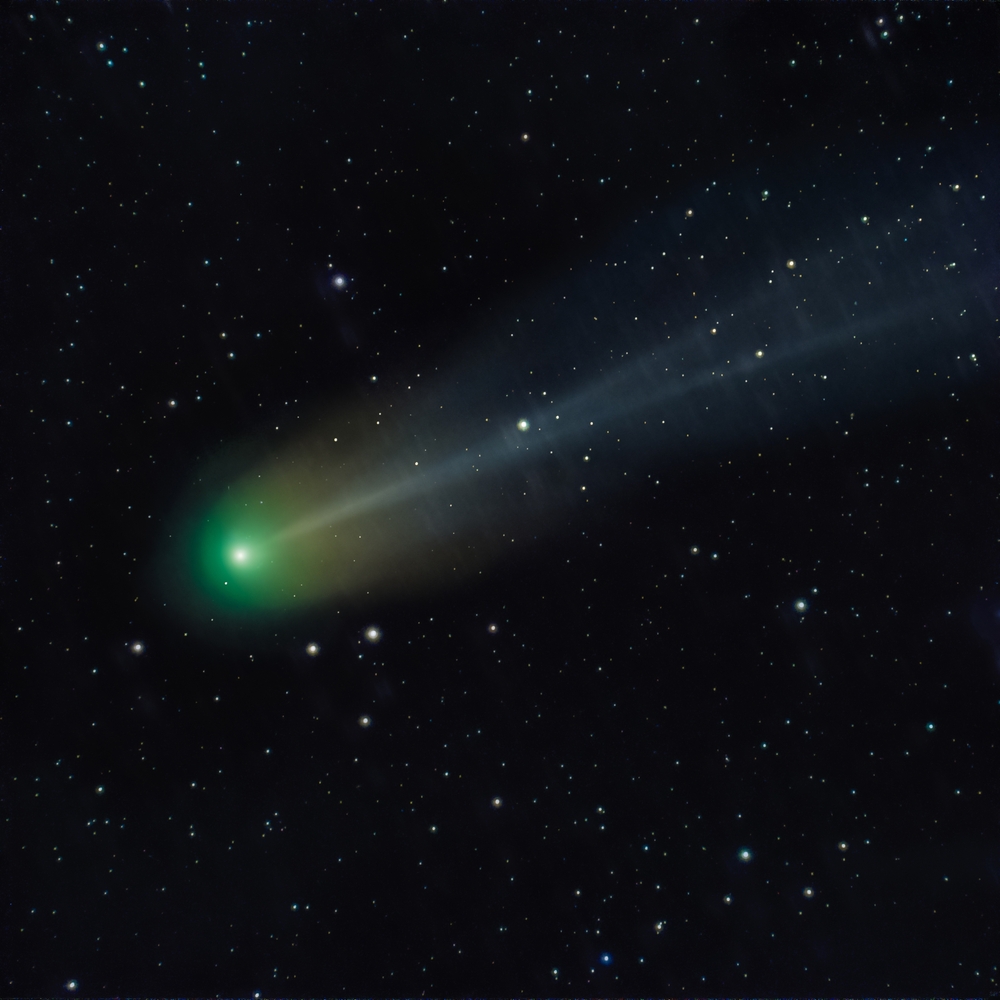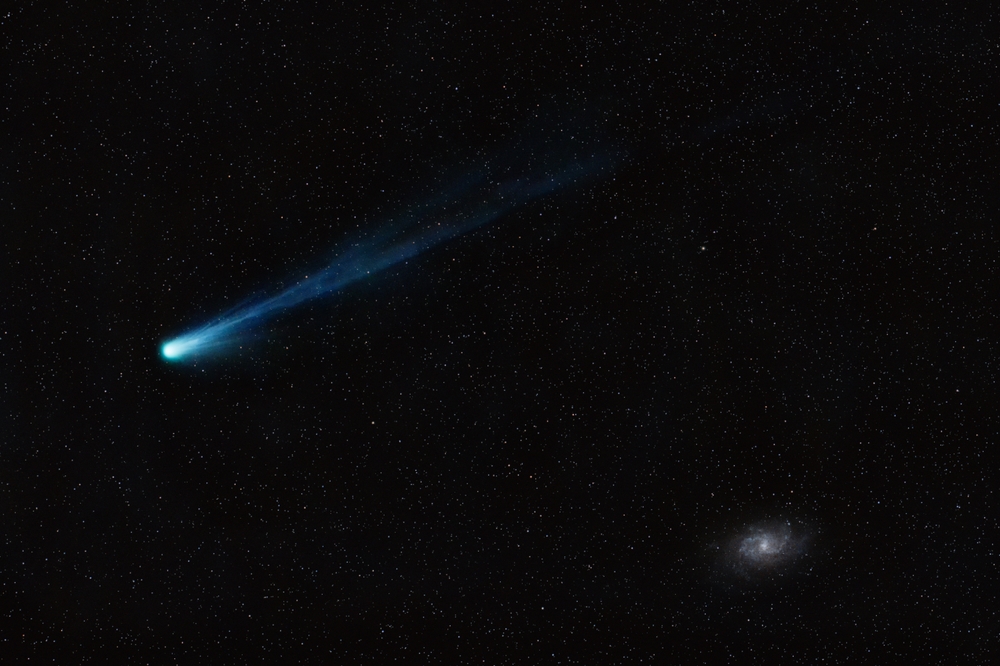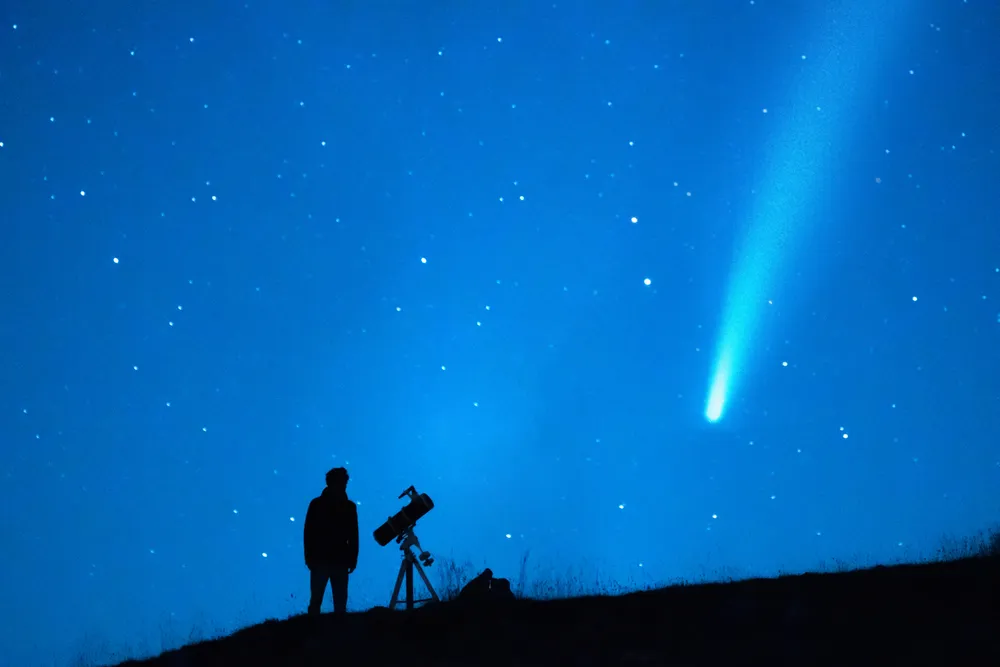Green “Mother of Dragons” Comet Now Visible in the Sky—How to See It

Over the past few months, millions of people have been preparing for the upcoming total solar eclipse on April 8. But though it will be the last time one will be visible from the U.S. for two decades, it’s not the only significant celestial event that’s taking place this month. That’s because a green comet that’s earned the nickname “Mother of Dragons” is now visible in the sky. Read on to learn why this visitor is so special and how you can see it.
RELATED: Here’s What You’ll See If It’s Cloudy During the Total Solar Eclipse.
Comet 12P/Pons-Brooks will soon be closer to Earth than it’s been in several decades.

It’s not every day that you encounter a celestial object that earns a handful of nicknames due to its unique appearance. But now, the passing visitor that has been dubbed the “Mother of Dragons” and “Millennium Falcon” comet is visible from the Northern Hemisphere.
The comet officially known as 12P/Pons-Brooks is now in the final stretch of its orbit approaching the sun, bringing it the closest it’s been to Earth in 71 years, according to the European Space Agency (ESA). The “Halley-style” object has a nucleus made of ice, dust, and rock that is about 19 miles wide that glows a brilliant green as it warms up the closer it gets to our solar system’s star.
The occasional visitor was first spotted by French astronomer Jean-Louis Pons in 1812, who noticed the dim object becoming brighter over the course of a month until it sprouted a tail and became visible to the naked eye. It wasn’t until British-American astronomer William R. Brooks verified the comet’s orbital period in 1883 that the object was named after its co-discoverers, per the ESA. However, historical records from China in the 14th century and Italy in the 15th century also make note of the passing visitor.
RELATED: New Star Will “Explode” in the Night Sky—How to See the “Once-in-a-Lifetime” Event.
The comet’s nicknames come from one of its unique characteristics.

Game of Thrones fans may appreciate the idea of a celestial object being named after Daenerys Targaryen. But Comet 12P/Pons-Brooks actually earned its “Mother of Dragons” monicker from the ESA because it is the likely source of the annual kappa-Draconids meteor shower, which occurs each late fall.
The comet’s other nicknames have a very different reasoning behind them. That’s because the object is one of less than two dozen known “cryovolcano comets,” which means it’s an active ice volcano that erupts as the comet warms up closer to the sun, according to Space.com. Last year, this created the unique appearance of “horns,” or giving the object the same shape as Han Solo’s iconic spaceship from the Star Wars saga.
This rare characteristic has also made it a significant point of interest for astronomers and scientists. Some are hoping to understand how frequently such “ice eruptions” occur as the object makes its fly-by of Earth.
“I would say it’s somewhat unusual in the number of outbursts it’s been having,” Dave Schleicher, PhD, an astronomer at Lowell Observatory in Arizona, told CNN. “On the other hand, it’s not like you have good records from the past to really let you know what is typical. And I suspect given the fairly large number of outbursts that have happened over the last eight months, that this is very clearly a usual occurrence for Pons-Brooks.”
RELATED: Here’s Exactly When You Can Look Directly at the Solar Eclipse, NASA Says.
It will reach its closest point to the sun later this month.

The comet is set to become its brightest when it reaches perihelion—or its closest point to the sun—this June, according to the ESA. But since it won’t be visible at night from the Northern Hemisphere by then, the agency says that early April provides those above the equator with the best opportunities to see the rare cryovolcano comet.
Regardless, the “Mother of Dragons” is expected to continue putting on a show well before its grand finale. And according to experts, it shouldn’t be too difficult to spot for now.
“The comet will brighten a bit as it gets closer to the sun, and it should be visible to the naked eye low in the west about an hour after sunset,” Paul Chodas, PhD, manager of the Center for Near-Earth Object Studies, and Davide Farnocchia, navigation engineer, at NASA’s Jet Propulsion Laboratory, told CNN in a joint email.
You can improve your viewing experience by leaving the city.

While catching a special celestial event involves being in the right place at the right time cosmically speaking, experts say where you are on Earth can also make a difference. For your best view, follow some of the basic tenets of stargazing.
“You should go to a location away from city lights and with an unobstructed view of the western horizon,” Choodas and Farnocchia told CNN. “It would be advisable to use a pair of binoculars, since the comet may be hard to locate without them.”
Surprisingly, Comet 12P/Pons-Brooks is also expected to appear during the eclipse and even become visible along with some other points of interest during totality. However, experts say it might not be the best use of your time trying to spot it.
“The comet would be located about 25 degrees away from the eclipsed sun,” Chodas and Farnocchia told CNN. “The comet should be fairly easy to find during the total solar eclipse, as well as a number of planets, but the main focus during those four minutes should be on the eclipse itself!”